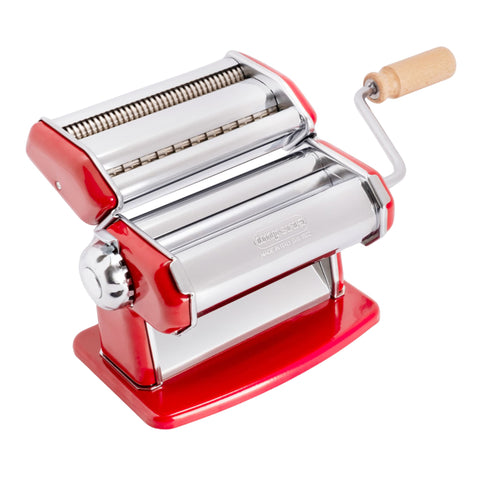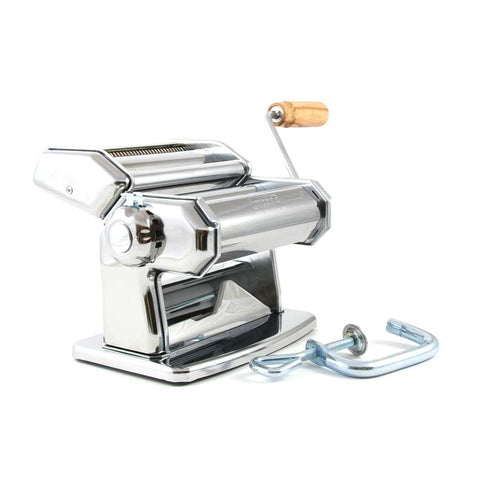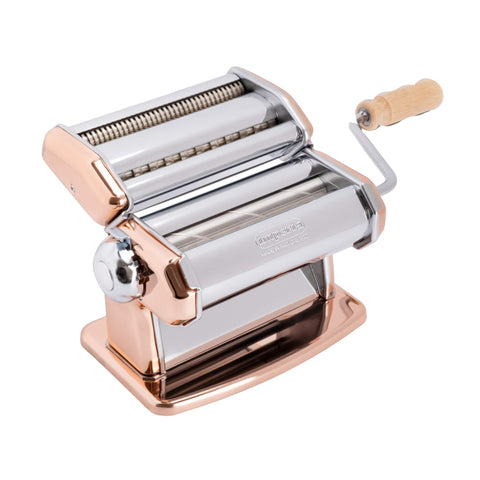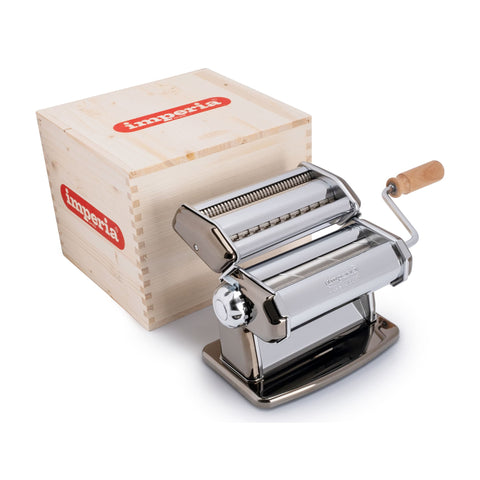Should I Buy A Pasta Maker? Tips From Italian Chef, Valentina Harris
by Valentina Harris

Is it worth getting a pasta maker? Chef Valentina Harris explains what to look for in a pasta maker, which pasta maker Italians use, and how to look after it properly.
This article was written by Valentina Harris for Sous Chef UK
Contents:
- Introduction
- What to look for in a pasta maker
- What pasta maker do Italian's use
- Are pasta makers worth it?
- Recipe 1 - Fresh egg pasta
- Recipe 2 - Ragu
- Recipe 3 - Limoncello cake
- How to care and clean your pasta maker
Regular:

–––
Introduction
Pasta can be divided into 2 main types, fresh egg pasta and dried durum wheat pasta. Fresh egg pasta can be made using a domestic pasta machine; whilst dried durum wheat flour has always been made in a factory and always will – you can’t use a pasta machine for this kind of pasta.
Fresh Egg Pasta is Pasta all’Uovo and is made using soft wheat flour and eggs, or a combination of durum wheat flour and soft wheat flour, and egg. To be precise, fresh egg pasta is made in egg’s worth, i.e.1 egg per person. Then for each egg you need 100 g of flour.
Durum wheat pasta is made with hard wheat flour and water and the resulting dough is just too hard and dense to be sufficiently kneaded. And to allow the gluten - the protein in the flour - to develop, and is also impossible to dry out properly, which is absolutely essential for good pasta.
Why can I not make durum wheat pasta at home?

Pasta that has not been dried properly before cooking might split and break up whilst boiling. Durum wheat pasta includes pasta like spaghetti, penne and rigatoni but there are 365 registered different pasta shapes available on the market. Spaghetti remains the top seller, out-selling all the other shapes by a dramatic 40%
Other types of pasta
There are then several other sub varieties to be taken into consideration such as:
- All the gluten-free types of pasta now available - using rice flour, pea flour and other gluten free substitutes;
- Hand made pasta like Orecchiette, Pici, Strozzapreti or Strascinati – all of which are much thicker and more solid than factory-made durum wheat pasta and subsequently have longer cooking times;
- Whole-wheat pasta;
- And finally those very niche, regional pasta varieties such as Pizzoccheri from Valtellina.
–––
What to look for in a pasta maker
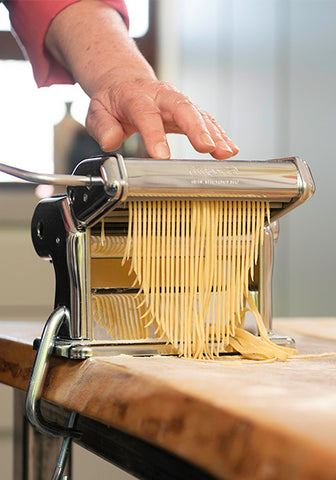
If you are going to invest in a pasta maker, make sure it is made in Italy, preferably one that carries the brand name Imperia pasta-maker.
The contents of your box will be:
- The machine itself;
- The crank handle that turns the 2 solid rollers that flatten and roll out the pasta to the desired even, silky thinness – it needs to feel like a really expensive pair of silk stockings as it glides through your fingers;
- The clamp that safely secures the machine to the table top or work surface;
- The cutting tool, which you only attach after you have finished rolling out and once the sheets of pasta are dry enough to cut and will cut your dough into Tagliatelle or Tagliolini;
- And finally a little tray to help you feed the sheets of dough through the machine straight.
–––
What pasta makers do Italians use
The favourite brand in Italy is definitely Imperia, whether hand cranked or electric.
A few years ago I had the honour of meeting the man who invented and created this machine in 1932. He was old and wise and told me how he simply wanted to make the job of making pasta at home easier for housewives everywhere, in particular for the many immigrants, so far from home who were missing their pasta.
Once in production, the main selling market for the machine was in fact the United States, but these days Imperia exports to over 77 countries worldwide.
–––
Are pasta makers worth it?
Definitely! What else can possibly give you the same deep satisfaction as a plate of perfect pasta you have made yourself from scratch even if it is just some delicate Tagliolini dressed with some lemon infused butter and some freshly chopped herbs.
Or some ricotta filled Ravioli tossed in a little Truffle Butter, all finished with a dusting of freshly grated Parmesan.
Or some beautiful, golden Tagliatelle (did you know they were created in honour of Lucrezia Borgia’s glorious golden hair?)
Do I need a pasta machine to make fresh pasta?
You can of course make Pasta all’Uovo without a pasta machine. You can use a good, heavy, long rolling pin, but the work will be much harder and certainly more difficult. Having a pasta machine simply makes the process much easier and more fun and the results can be incredibly rewarding.
Over the course of my career, I have made literally miles of fresh pasta using my machine, and I have taught thousands of people how to achieve beautiful golden Tagliatelle and plump, pillow-like Ravioli, and I have developed some useful hints and tips to help you make the most of your own machine.
I know from what my students have told me over the years that many people own a machine that has tentatively been used once or twice and then left at the back of a cupboard to gather dust, never to be used again. So let me share my expertise with you and hopefully your pasta machine will be used to achieve some spectacular and delicious results.
–––
Recipes
Making fresh egg pasta
Regular:
To be precise, fresh egg pasta is made in egg’s worth, i.e.1 egg per person. Then for each egg you need 100 g of flour.
How to colour and flavour your fresh pasta
You can colour and flavour the basic dough by adding spinach puree for green pasta, squid ink for black pasta, saffron for deep golden pasta or powdered mushroom or truffle.
Some recipes suggest adding salt. I don’t personally recommend this. Salt is probably one of the most powerful ingredients you have in your kitchen because it doesn’t just enhance flavours, it also dries out and hardens other ingredients. If you add salt to pasta dough, you will end up with harder dough that will be difficult to roll out.
Other recipes recommend adding oil to the dough, which in my experience just makes the dough a little bit greasy, and that grease can be hard to completely remove from the pasta machine, and oil can go rancid quite quickly, which will make future pasta taste peculiar.
–––
Classic Ragu alla Bolognese
This very old fashioned sauce for pasta is traditionally used to dress Tagliatelle or for Lasagna or Cannelloni. The important thing is to keep the meat looking like chopped meat rather than mince. Makes enough to lightly dress 400 g pasta
Find more pasta making recipes.
–––
How to clean and care for your pasta maker
The most important thing is NEVER to wash the machine or expose it to water or damp, as the inner workings of the machine will simply seize up and rust, but will never dry out properly, as I have found out many times!
I was once teaching a pasta class in South Africa, at a beautiful winery near Stellenbosch, where the local catering schools and colleges had very kindly pooled all their machines in order to supply enough machines for the class to go ahead – 60 machines in total.
On the day of the class, we all waited and waited for the pasta machines to arrive. They were horribly late and I had to rearrange the order of what I was covering in the class accordingly as we continued to hope they would arrive.
Eventually, it became obvious something had gone horribly wrong! Turned out that a lovely, very keen student who had been chosen to take delivery of the machines from various quarters and then deliver them to the winery had wanted me to have nice clean machines to offer my students, and had conscientiously soaked all the machines overnight in soapy water…disaster!!
The class went ahead regardless, but we had to use wine bottles to roll the pasta out, which was hard work indeed!
If you look after this remarkable little machine with love and care, you will be handing it down through several generations and it will continue to give joy and satisfaction. You can also get replacement parts for these machines should you need to, if any of the parts ever wear out.
The most important thing is NEVER to wash the machine or expose it to water or damp, as the inner workings of the machine will simply seize up and rust, but will never dry out properly, as I have found out many times!
Top tips for looking after your pasta machine
- Don’t ever wash it or wipe it with a wet cloth
- Keep it away from any liquid - just in case of accidental spills
- When you’ve finished using it, just wipe it with a clean, dry cloth and/or brush it with a clean pastry brush
- Once used place it somewhere dry and safe until the next time you need it
- Most of all enjoy using this beautiful little piece of kit and don’t let it moulder at the back of a cupboard!
Using your pasta machine
It is really important that the pasta machine be clamped securely during the pasta rolling process as it is going to take a lot of pressure and some force - it really will be a nightmare if the machine is dancing and sliding around while you try to crank the handle. Find a table or work top edge where it will fit properly, if necessary wedge a folded towel or piece of wood to help it fit really securely or temporarily remove a drawer to help the clamp hook on properly.
Shop Pasta Machines:
–––
Feeling Inspired? Why not check out our other pasta making recipes, learn how to make squid ink pasta dough or learn how to make ravioli. Or shop our imperia pasta machine.
–––

About the author
Valentina Harris is a passionate Italian cook and award-winning author with more than 30 books to her name, including The Italian Regional Cookbook; Risotto! Risotto!; Classic Recipes of Tuscany; 500 Italian Recipes, and Valentina Harris’s Complete Italian Cookery Course. Educated in Italy, Valentina brought her qualifications for teaching and cooking from Rome to London in 1976. As a regular face at food festivals in the UK, Valentina stills finds time to share her expertise and love of Italian food by hosting courses, plus can be found regularly contributing to radio, TV, newspapers, and magazines.


